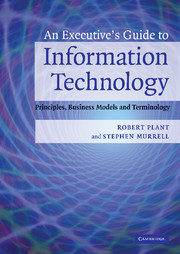Book contents
- Frontmatter
- Contents
- Introduction
- A ACM (Association for Computing Machinery) to Audio
- B Backup to Business process re-engineering
- C C, C++, C# to Cracking
- D Database to Dynamic web pages
- E e-Commerce/e-business to European Union Directive on Privacy and Electronic Commerce 2002
- F Fiber optics to Fuzzy logic
- G to H Global positioning system to Hypertext, HTML
- I ICANN (Internet Corporation for Assigned Names and Numbers) to ISP (Internet service provider)
- J to L Java to Logic programming
- M Machine learning to Multicast
- N Natural language processing (NLP) to Normalization
- O Object-oriented to Outsourcing
- P Packet switching and circuit switching to Public key-private key
- Q to R Quantum computing to RSS (Really simple syndication)
- S Sarbanes-Oxley Act of 2002 (SOX) to Structured design methodologies
- T to U T-Carrier to URL (Uniform resource locator)
- V Value added network (VAN) to Voice over IP (VoIP)
- W W3C (the World Wide Web Consortium) to WYSIWYG
- X to Z X.12 to Zip
- Index
- References
D - Database to Dynamic web pages
Published online by Cambridge University Press: 17 May 2010
- Frontmatter
- Contents
- Introduction
- A ACM (Association for Computing Machinery) to Audio
- B Backup to Business process re-engineering
- C C, C++, C# to Cracking
- D Database to Dynamic web pages
- E e-Commerce/e-business to European Union Directive on Privacy and Electronic Commerce 2002
- F Fiber optics to Fuzzy logic
- G to H Global positioning system to Hypertext, HTML
- I ICANN (Internet Corporation for Assigned Names and Numbers) to ISP (Internet service provider)
- J to L Java to Logic programming
- M Machine learning to Multicast
- N Natural language processing (NLP) to Normalization
- O Object-oriented to Outsourcing
- P Packet switching and circuit switching to Public key-private key
- Q to R Quantum computing to RSS (Really simple syndication)
- S Sarbanes-Oxley Act of 2002 (SOX) to Structured design methodologies
- T to U T-Carrier to URL (Uniform resource locator)
- V Value added network (VAN) to Voice over IP (VoIP)
- W W3C (the World Wide Web Consortium) to WYSIWYG
- X to Z X.12 to Zip
- Index
- References
Summary
Definition: An organized collection of information.
Overview
A collection of files and records is just raw data. Once it has been organized, rationalized, and formatted so that it can be effectively accessed in a uniform way, enabling general queries to be answered by a simple procedure, it becomes a database.
Rational organization is of course essential for any effective record keeping, but for a database system the demands are far more rigorous. A database system will be expected to be able to answer queries totally automatically. To answer even the simplest of queries, such as “what is the salary of the employee named Q. X. Smith in the advertising department?,” mechanically, without any access to intelligence, requires an established format to the data. A human searcher could simply leaf through all the employee records; they would easily be able to pick out the employee's name and their departmental assignment from each form, because everybody knows what proper names look like. It is just common sense; nobody would ever confuse a department name with a social-security number even if they were written in unexpected places on the form.
Of course, computers don't have common sense, and can't be expected to know what makes a credible name for a human. For any such query to be answerable, every single employee record must be formatted uniformly, so that the query application knows exactly where in each record to find the employee's name, department, and salary.
- Type
- Chapter
- Information
- An Executive's Guide to Information TechnologyPrinciples, Business Models, and Terminology, pp. 88 - 122Publisher: Cambridge University PressPrint publication year: 2007



